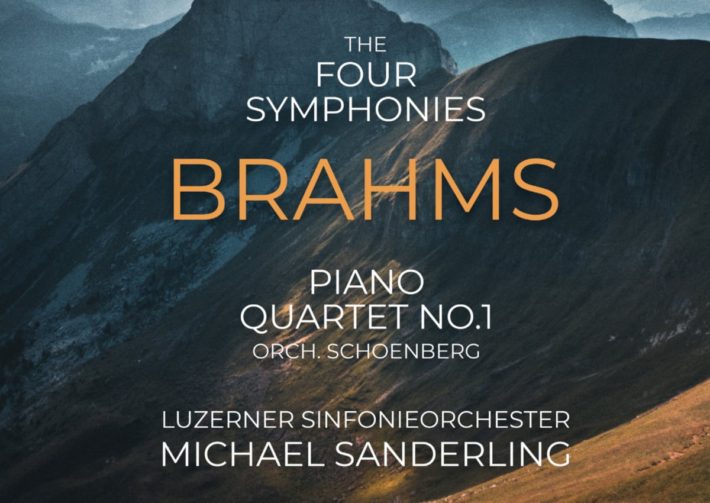The Luzerner Sinfonieorchester and their chief conductor begin their long-term Warner Classics recording agreement with this new set of Brahms symphonies. Collectors can choose from over sixty complete cycles and hundreds of individual symphony recordings, so any new recording has to offer a unique and compelling insight into this repertoire. These complete set normally include the overtures and Haydn variations, but here we have Schoenberg’s orchestration of Brahms’ first piano quartet.
I last reviewed a Brahms cycle in August 2022, performances by Adam Fischer and the Danish Chamber Orchestra (Naxos). The contrast between his approach and Sanderling’s could not be more different. Whereas Fischer fully embraces a historically informed performance practice, Sanderling exhibits no awareness of the changing interpretive ideas heard over the past 70 years. His are solidly traditional readings, similar in approach to his father’s readings in Dresden (Eurodisc) and Berlin (Capriccio).
The Lucerne strings are lean and silky, the forwardly balanced woodwinds reminiscent of Klemperer’s recordings. The brass has a burnished warmth, timpani are always articulate and the percussion in the fourth and Schoenberg orchestration is perfectly integrated into the overall sound. If Lucerne lacks the Teutonic weight of Berlin and Vienna, it is still a cultivated and convincing Brahms sound.
Every strand of the orchestral texture is heard, thanks to the excellence of the engineering and playing. Yet, despite these many excellent qualities, misjudgments in tempo and characterization often result in disappointing performances. Sanderling’s overriding interpretive priority seems to be sheer beauty of sound and a rather unvaried approach to phrasing and articulation. Everything is rounded, the players never encouraged or make a sharp attack or brash tone. Readers who resent the influence historically informed practice on romantic repertoire may find this approach heaven sent. But this ‘one size fits all’ approach, wedded to an objective “let the music speak for itself) stance, seriously undermines the music’s dramatic intensity.
Related Classical Music Reviews
- Brahms – Symphony No. 1 – A Beginners Guide
- Review: Brahms – Symphony No. 4 – Pittsburgh Symphony Orchestra, Manfred Honeck
- Review: Brahms – Symphony No. 4 – Swedish Chamber Orchestra, Dausgaard
The opening of the first symphony is suitably imposing, timpani weighty without dominating the texture, the interweaving between winds and strings beautifully realized. But the tempo chosen for the Allegro is too slow, and there is no real contrast between the driven first theme and sweeter second theme. The music’s restless sense of searching is never fully expressed. The second movement Andante is again too slow and imparts a far different (and unconvincing) character to the movement. The playfulness of the third movement is ideally caught, and the opening of the last movement is vividly characterized. But when the chorale/Ode to Joy melody begins, the intensity lessens and the emotional temperature remains low, the coda merely sonorous, whereas with Jochum and the LPO (also Warner Classics) it brings an overwhelming sense of catharsis.
The second symphony has similar issues: at a little over 21 minutes, this is the longest performance of the opening movement I know. Moreover, articulation and bowing create the sense of unending legato. Karajan was often accused of the same, but his three Berlin readings still have greater energy and a wider variety of articulation. The tempo and mood of the second movement are not a contrast to the first but rather a continuation of it, and the third movement feels too serious. And despite much interesting inner detail, the final movement is again emotionally cool, its coda lacking the jubilant rambunctiousness conjured by Chailly (Gewandhaus/Decca), Karajan (DG) and Kleiber (Vienna Philharmonic DVD/DG).
The third symphony is better suited to Sanderling’s approach: the beautifully shaped second movement has an autumnal glow, its opening dialogue between strings and woodwinds sweetly sung. The third movement’s tempo is unexpectedly fast, bringing a refreshing buoyancy – where did this tempo come from? That momentum carries over into the opening of final movement, but a few minutes in the momentum begins to slacken, though the coda is beautifully done.
The first movement of the fourth is somnolent, lasting 90 plus-seconds longer than his father in Dresden, Walter’s Columbia Symphony recording (Sony), and Blomstedt’s recent Gewandhaus album (Pentatone). Beauty of playing is simply not enough – there is real struggle and angst in this music, fully realized in Honeck’s superb Pittsburg reading (Reference). The following Andante moderato is cut from the same interpretational cloth, so that there is virtually no contrast with the opening movement. The Allegro giocoso is graceful, but heavy-handed and the final movement begins in underwhelming fashion but eventually builds to an impressive final peroration.
Schoenberg’s orchestration of the piano quartet is a substantial and fascinating addition. It is also the best performance in the set, with far higher levels of enthusiasm and drama. If only the symphonies were at the same level.

Johannes Brahms: The Symphonies & Piano Quartet No. 1 (Schoenberg)
Luzerner Sinfonieorchester
Michael Sanderling – Conductor
Warner Classics, CD 5419748237
Related Albums
Read more classical music reviews or visit The Classic Review Amazon store
Follow Us and Comment:
[wd_hustle id=”HustlePostEmbed” type=”embedded”]











